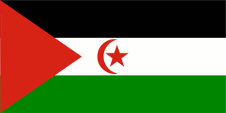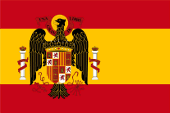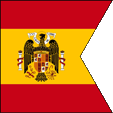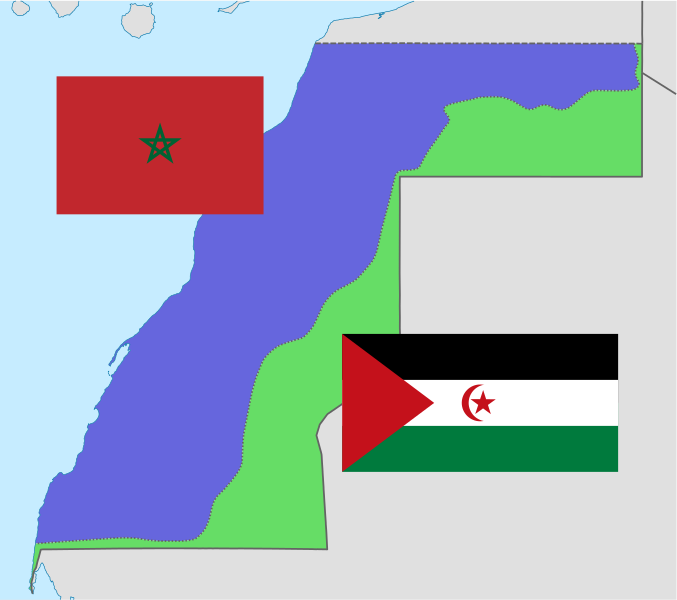mobile View, to the German Version tap the flag


- Arabic Democratic Sahara Republic
- Democratic Arabic Republic of Saharawi
- DARS
- to Morocco belonging former Spanish colony and for independence fighting state in Southern Morocco
- international partially recognized
- former name: Rio de Oro
• Flag
• Historical Flags
• Meaning/Origin of the Flag
• Coat of Arms
• Meaning/Origin of the Coat of Arms
• Map
• Numbers and Facts
• History
• Origin of the Country's Name

Flag of the Sahara Republic,
ratio = 1:2,
Source, by: Wikipedia (EN)







1945–1976,
Flag of Spain,
ratio = 2:3,
Source, by: Wikipedia (EN)




1945–1976,
Standard of the Governor of Spanish Sahara,
ratio = 1:1,
Source, by: Die Welt im bunten Flaggenbild




The flag was introduced on 27th of February in 1976. It shows the pan-arabian colours in three horizontal stripes in black, white and green and on the leech an isosceles red triangle. In the white stripe a red half-moon and a red star. The half-moon and the star are islamic symbols. Red is the colour of socialism. The colour quartet of four, green, white, black and red is a special Arabian colours symbol, the Panarabian colours. The (Pan)Arabian colours were officially introduced by the Sheriff Hussein of Mekka – of the lineage of the Hashemides – as colours of the Arabian Movement during the First World War at the secession of the Kingdom of Hedjas from the Ottoman Empire. The flag of Hedjas served as pattern. The colours have the following meaning: Red is the colour of Omar, the second calif; white stands for the Omajiades, a calif-dynasty, which goes back to the fifth calif Moawija I.; green stands for the Fatimides, a ismailitic-shiit calif-dynasty, which goes back to the fourth calif Ali; and black stands for the Abbasides, a calif-dynasty, which goes back to the calif Abbas I. Red is also the colour of the Hashemides, an Arabian sovereign-dynasty, which probably goes back to Hashim ibn Abd al-Manaf, the grandfather of Mohammed. Green is in addition generally the colour of Islam, and does not refer only to the Arabian countries. The islamic symbolism, with thw half-moon and the star, is from Ottoman origin. The last Calif (from the house of the Abbaside's) was executed in 1258. The Calif – successor of Mohammed – was the religious and worldly head of the "Islamic Empire". About 1460 the Califate was revitalized by the ruler of the Ottoman Empire. This function became more important as the Turks conquered Mecca Town in 1517, as they became the supreme protectors and preservers of the holy places. The control over the holy places got lost during the First World War (Mecca 1916, Medina 1918). In 1924 the Califate became abolished by the Turkish national congregation. In this way became half-moon and star spreaded in the whole world as the Symbols of Islam. The coupling of that symbols with green flags has its roots in the ottoman panislamism. As there arised independence movements in some regions of the Ottoman Empire, encounts Abdul Hamid II. these movements successful with the unifying string of panislamism. To the symbol of the panislamism he made the green flag (colour of the overcoat of the Prophet Mohammed), and layed above the Turkish coat of arms. The flag of the Islam was created.
Source:
Die Welt der Flaggen,
Volker Preuß


1955–1975,
Coat of arms of Spanish Sahara,
Source, by: Wikipedia (EN)

Coat of arms of the Sahara Republic,
Source, by:
Wikipedia (EN)

The coat of arms of the Spanish Sahara was red with a green central shield, on it a diagonal white-blue wavy line, above a palm tree, below a camel. The red border showed alternately the symbolism of Castile and a silver lion. The coat of arms of the Sahara Republic shows two crossed rifles (fight for freedom) each with a flag of the Sahara Republic, above it a crescent and star in red (Islam), below it a red banner with the Arabic inscription: "Hurriya, Dimuqratiya, Wahda" → "Freedom Democracy Unity". On the right and left are two olive branches (peace).
Source:
Wikipedia (EN)


Source: Abjiklam, CC BY-SA 4.0, via Wikimedia Commons

Western Sahara
Area: 102.703 square miles
Inhabitants: 597.000 (2019), thereof ca. 50 % Arabs, ca. 50 % Sahraouis (mixed Arab-Berber population)
Religions: 99% Muslim
Density of Population: 3 inh./sq.mi.
Capital: Al Aaiun' (El Aaiún, El Ayun, Laayoun) 217.700 inh. (2014)
Languages: Arabian, Berberian, Spanish
Time Zone: GMT + 1 h

Sahrawi Republic
Area: 34.363 square miles
Inhabitants: ca. 55.000 (2013), mostly Sahraouis (mixed Arab-Berber population)
Religions: 99% Moslems
Density of Population: 1,6 inh./sq.mi.
Main Place: Tifariti, 3092 inh. (2004)
Seat of the POLISARIO: Tindouf (in Algeria)
Languages: Arabian, Berberian, Spanish
Currency:
• 1 Algerian Dinar (DA, DZD) = 100 Centimes
• 1 Moroccan Dirham (MAD) = 100 Centimes
• 1 Mauritanian Ouguiya (MRU, UM) = 5 Khoums
• 1 Sahrawi Peseta (EHP, Pta.) = 100 Céntimos
Time Zone: GMT + 1 h
Source:
Wikipedia (EN),
Wikipedia (DE)

11th–12th century · to the Empire of the Almoravides
1434 · the Portugese seafarer Gil Eannes passes Cape Bojador and discovers the today’s coast of West Sahara
15th–19th cent. · Portugese and Spaniards trade at the coast, establish ports and trade points
1884 · Spain begins with the colonization of the coast
1885 · Spain declares the coast line between Cape Bojador and Cape Blanc to the Spanish protectorate Rio de Oro
1946 · Rio de Oro becomes summarized with the City of Ifni (in the today’s Morocco, appropriated already in 1860) to the Colony of Spanish West Africa
1958 · Río de Oro and Saguia Al Hamra become declared to the Overseas Province of Spanish Sahara (Provincia Española de Sáhara)
1968 · Spain ignores the UNO resolution 2428 for the preparation of the independence of Spanish Sahara, establishment of initial liberation movements
1972 · Spain begins with the mining of phosphate
1973 · foundation of POLISARIO (People's Front for the Liberation of Saqiya al-Hamra and Rio de Oro), onset of the struggle for independence
1975 · Morocco provokes a gigantic peaceful invasion in Spanish Sahara, Spain gives up its colony, Morocco and Mauritania divide the country and take over the administration provisionally
1976 · withdrawal of the last Spanish troops, POLISARIO proclames in Bir Lehlou the Democratic Arabic Republic of Sahara (DARS) on the 27th of February, Morocco and Mauritania annex the by them administered areas
1979 · Mauritania disclaims for its part of Western Sahara in favour of POLISARIO and DARS, Morocco annexes that area as well
1982 · the DARS becomes incorporated in the OAU, Morocco leaves because of that the OAU
1984 · in total 60 states have recognized diplomatical the ADRS since 1976
1988 · UNO's plan of peace, negotiations between Morocco and POLISARIO
1989 · the negotiations between Morocco and POLISARIO have none results
1991 · cease fire, organization of a plebiscite by the UNO about the independence
1993 · new negotiations between Morocco and POLISARIO have once more none results
1995 · apprehension of over 100 DARS demonstrators in El Aaiun
1996 · the UNO stops the registration of voters momentarily, the POLISARIO threatens with new war
1999 · the Moroccan police terminates pro-DARS-demonstrations in the whole country
2000 · new negotiations between Morocco and POLISARIO, pro-DARS-demonstrations in El Aaiun
2020 · the POLISARIO declares the condition of war
Source:
Atlas zur Geschichte,
World Statesmen,
Wikipedia (D)

The name "Western Sahara" was used for the first time not until the withdrawal of the Spaniards. In the times before the country was called "Spanish Sahara". "Sahara" is assumed generally as an Arabic synonymous for "desert", but it is translated with "ochre" and means the colour of the sandy soil. The northern part of the country (31 660 sq.mi.) is called "Saguia Al Hamra", possibly to translate with "Red Valley". The southern part of the country (71 040 sq.mi.) is called "Rio de Oro", a Spanish name, it means "River of Gold", although there is no river and as well no gold.
Source:
Handbuch der geographischen Namen,
Wikipedia (D),
Volker Preuß


![]()












